On the Flow Structure and Dynamics of Methane and Syngas Lean Flames in a Model Gas-Turbine Combustor
Abstract
1. Introduction
2. Experimental Setup
2.1. Combustor
2.2. Measurement Equipment
2.3. Data Processing
3. Results
3.1. Average Flow Structure
3.2. Coherent Flow Structures
3.3. High-Speed Imaging of Flame Front Dynamics
4. Conclusions
Supplementary Materials
Author Contributions
Funding
Data Availability Statement
Acknowledgments
Conflicts of Interest
References
- Wang, T.; Stiegel, G. Integrated Gasification Combined Cycle (IGGC) Technologies; Elsevier: New York, NY, USA, 2017. [Google Scholar]
- Higman, C.; van der Burgt, M. Gasification; Elsevier: New York, NY, USA, 2010. [Google Scholar]
- Dunn-Rankin, D. Lean Combustion: Technology and Control; Academic Press: Cambridge, UK, 2008. [Google Scholar]
- Johnson, M.R.; Littlejohn, D.; Nazeer, W.A.; Smith, K.O.; Cheng, R.K. A comparison of the flowfields and emissions of high-swirl injectors and low-swirl injectors for lean premixed gas turbines. Proc. Combust. Inst. 2005, 30, 2867–2874. [Google Scholar] [CrossRef]
- Cheng, R.K.; Littlejohn, D.; Strakey, P.A.; Sidwell, T. Laboratory investigations of a low-swirl injector with H2 and CH4 at gas turbine conditions. Proc. Combust. Inst. 2009, 32, 3001–3009. [Google Scholar] [CrossRef]
- Asai, T.; Dodo, S.; Karishuku, M.; Yagi, N.; Akiyama, Y.; Hayashi, A. Performance of multiple-injection dry low-NOx combustors on hydrogen-rich syngas fuel in an IGCC pilot plant. J. Eng. Gas Turbines Power 2015, 137, 091504. [Google Scholar] [CrossRef]
- Meier, W.; Weigand, P.; Duan, X.R.; Giezendanner-Thoben, R. Detailed characterization of the dynamics of thermoacoustic pulsations in a lean premixed swirl flame. Combust. Flame 2007, 150, 2–26. [Google Scholar] [CrossRef]
- Davis, D.W.; Therkelsen, P.L.; Littlejohn, D.; Cheng, R.K. Effects of hydrogen on the thermo-acoustics coupling mechanisms of low-swirl injector flames in a model gas turbine combustor. Proc. Combust. Inst. 2013, 34, 3135–3143. [Google Scholar] [CrossRef]
- Huang, Y.; Yang, V. Dynamics and stability of lean-premixed swirl-stabilized combustion. Prog. Energy Combust. Sci. 2009, 35, 293–364. [Google Scholar] [CrossRef]
- Lieuwen, T.; Torres, H.; Johnson, C.; Zinn, B.T. A mechanism of combustion instability in lean premixed gas turbine combustors. J. Eng. Gas Turbines Power 2001, 123, 182–189. [Google Scholar] [CrossRef]
- Candel, S.; Durox, D.; Schuller, T.; Bourgouin, J.-F.; Moeck, J.P. Dynamics of swirling flames. Ann. Rev. Fluid Mech. 2014, 46, 147–173. [Google Scholar] [CrossRef]
- Lieuwen, T.C. Unsteady Combustor Physics; Cambridge University Press: Cambridge, UK, 2021. [Google Scholar]
- Lieuwen, T.; Yang, V.; Yetter, R. Synthesis Gas Combustion: Fundamentals and Applications; CRC Press: New York, NY, USA, 2009. [Google Scholar]
- Beerer, D.; McDonell, V.; Therkelsen, P.; Cheng, R.K. Flashback and turbulent flame speed measurements in hydrogen/methane flames stabilized by a low-swirl injector at elevated pressures and temperatures. J. Eng. Gas Turbines Power 2014, 136, 031502. [Google Scholar] [CrossRef]
- Janus, B.; Dreizler, A.; Janicka, J. Experimental study on stabilization of lifted swirl flames in a model GT combustor. Flow Turbul. Combust. 2005, 75, 293–315. [Google Scholar] [CrossRef]
- Wehr, L.; Meier, W.; Kutne, P.; Hassa, C. Single-pulse 1D laser Raman scattering applied in a gas turbine model combustor at elevated pressure. Proc. Combust. Inst. 2007, 31, 3099–3106. [Google Scholar] [CrossRef]
- Lazik, W.; Doerr, T.; Bake, S.V.; vd Bank, R.; Rackwitz, L. Development of lean-burn low-NOx combustion technology at Rolls-Royce Deutschland. In Proceedings of the ASME Turbo Expo 2008: Power for Land, Sea and Air, Berlin, Germany, 9–13 June 2008; Volume 43130, pp. 797–807. [Google Scholar] [CrossRef]
- Dhanuka, S.K.; Temme, J.E.; Driscoll, J.F. Unsteady aspects of lean premixed prevaporized gas turbine combustors: Flame-flame interactions. J. Eng. Gas Turbines Power 2011, 27, 631–641. [Google Scholar] [CrossRef]
- Meier, U.; Freitag, S.; Heinze, J.; Lange, L.; Magens, E.; Schroll, M.; Willert, C.; Hassa, C.; Bagchi, I.K.; Lazik, W.; et al. Characterization of lean burn module air blast pilot injector with laser techniques. J. Eng. Gas Turbines Power 2013, 135, 121508. [Google Scholar] [CrossRef]
- Temme, J.E.; Allison, P.M.; Driscoll, J.F. Combustion instability of a lean premixed prevaporized gas turbine combustor studied using phase-averaged PIV. Combust. Flame 2014, 161, 958–970. [Google Scholar] [CrossRef]
- Canepa, E.; Nilberto, A. Experimental flame front characterisation in a lean premix burner operating with syngas simplified model fuel. Energies 2019, 12, 2377. [Google Scholar] [CrossRef]
- Greifenstein, M.; Heinze, J.; Willert, C.; Voigt, L.; Zedda, M.; Richter, C.; Dreizler, A. Time-resolved temperature profile measurements in the exhaust of a single sector gas turbine combustor at realistic operating conditions. Exp. Fluids 2020, 61, 177. [Google Scholar] [CrossRef]
- Stöhr, M.; Sadanandan, R.; Meier, W. Phase-resolved characterization of vortex–flame interaction in a turbulent swirl flame. Exp. Fluids 2011, 51, 1153–1167. [Google Scholar] [CrossRef]
- Boxx, I.; Arndt, C.M.; Carter, C.D.; Meier, W. High-speed laser diagnostics for the study of flame dynamics in a lean premixed gas turbine model combustor. Exp. Fluids 2012, 52, 555–567. [Google Scholar] [CrossRef]
- Coriton, B.; Steinberg, A.M.; Frank, J.H. High-speed tomographic PIV and OH PLIF measurements in turbulent reactive flows. Exp. Fluids 2014, 55, 1–20. [Google Scholar] [CrossRef]
- Liu, X.; Wang, S.; Wang, G.; Xu, L.; Li, L. High-speed simultaneous PLIF/PIV imaging of a lift-off swirling flame under acoustic forcing. Exp. Therm. Fluid Sci. 2021, 121, 110259. [Google Scholar] [CrossRef]
- Allen, M.G.; Parker, T.E.; Reinecke, W.G.; Legner, H.H.; Foutter, R.R.; Rawlins, W.T.; Davis, S.J. Fluorescence imaging of OH and NO in a model supersonic combustor. AIAA J. 1993, 31, 505–512. [Google Scholar] [CrossRef]
- Bombach, R.; Käppeli, B. Simultaneous visualisation of transient species in flames by planar-laser-induced fluorescence using a single laser system. Appl. Phys. 1999, 68, 251–255. [Google Scholar] [CrossRef]
- Sick, V. Exhaust-gas imaging via planar laser-induced fluorescence of sulfur dioxide. Appl. Phys. B 2002, 74, 461–463. [Google Scholar] [CrossRef][Green Version]
- Mosburger, M.; Sick, V. Single laser detection of CO and OH via laser-induced fluorescence. Appl. Phys. B 2010, 99, 1–6. [Google Scholar] [CrossRef]
- Bessler, W.G.; Schulz, C. Quantitative multi-line NO-LIF temperature imaging. Appl. Phys. B 2004, 78, 519–533. [Google Scholar] [CrossRef]
- Yang, X.; Fu, C.; Wang, G.; Li, Z.; Li, T.; Gao, Y. Simultaneous high-speed SO2 PLIF imaging and stereo-PIV measurements in premixed swirling flame at 20 kHz. Appl. Opt. 2019, 58, C121–C129. [Google Scholar] [CrossRef] [PubMed]
- Liu, X.; Wang, Y.; Wang, Z.; Qi, F. Single camera 20 kHz two-color formaldehyde PLIF thermometry using a dual-wavelength-switching burst mode laser. Opt. Lett. 2021, 46, 5149–5152. [Google Scholar] [CrossRef]
- Najm, H.N.; Paul, P.H.; Mueller, C.J.; Wyckoff, P.S. On the adequacy of certain experimental observables as measurements of flame burning rate. Combust. Flame 1998, 113, 312–332. [Google Scholar] [CrossRef]
- Fayoux, A.; Zähringer, K.; Gicquel, O.; Rolon, J. Experimental and numerical determination of heat release in counterflow premixed laminar flames. Proc. Combust. Inst. 2005, 30, 251–257. [Google Scholar] [CrossRef]
- Röder, M.; Dreier, T.; Schulz, C. Simultaneous measurement of localized heat-release with OH/CH2O–LIF imaging and spatially integrated OH∗ chemiluminescence in turbulent swirl flames. Proc. Combust. Inst. 2013, 34, 3549–3556. [Google Scholar] [CrossRef]
- Kariuki, J.; Dowlut, A.; Yuan, R.; Balachandran, R.; Mastorakos, E. Heat release imaging in turbulent premixed methane–air flames close to blow-off. Proc. Combust. Inst. 2015, 35, 1443–1450. [Google Scholar] [CrossRef]
- Dulin, V.M.; Lobasov, A.S.; Chikishev, L.M.; Markovich, D.M.; Hanjalic, K. On impact of helical structures on stabilization of swirling flames with vortex breakdown. Flow Turbul. Combust. 2019, 103, 887–911. [Google Scholar] [CrossRef]
- Copeland, C.; Friedman, J.; Renksizbulut, M. Planar temperature imaging using thermally assisted laser induced fluorescence of OH in a methane–air flame. Exp. Therm. Fluid Sci. 2007, 31, 221–236. [Google Scholar] [CrossRef]
- Kostka, S.; Roy, S.; Lakusta, P.J.; Meyer, T.R.; Renfro, M.W.; Gord, J.R.; Branam, R. Comparison of line-peak and line-scanning excitation in two-color laser-induced-fluorescence thermometry of OH. Appl. Opt. 2009, 48, 6332–6343. [Google Scholar] [CrossRef]
- Dulin, V.; Sharaborin, D.; Tolstoguzov, R.; Lobasov, A.; Chikishev, L.; Markovich, D.; Wang, S.; Fu, C.; Liu, X.; Li, Y.; et al. Assessment of single-shot temperature measurements by thermally-assisted OH PLIF using excitation in the A2Σ+–X2Π (1-0) band. Proc. Combust. Inst. 2021, 38, 1877–1883. [Google Scholar] [CrossRef]
- Grib, S.W.; Fugger, C.A.; Hsu, P.S.; Jiang, N.; Roy, S.; Schumaker, S.A. Two-dimensional temperature in a detonation channel using two-color OH planar laser-induced fluorescence thermometry. Combust. Flame 2021, 228, 259–276. [Google Scholar] [CrossRef]
- Stöhr, M.; Sadanandan, R.; Meier, W. Experimental study of unsteady fame structures of an oscillating swirl fame in a gas turbine model combustor. Proc. Combust. Inst. 2009, 32, 2925–2932. [Google Scholar] [CrossRef]
- Stöhr, M.; Boxx, I.; Carter, C.D.; Meier, W. Experimental study of vortex-flame interaction in a gas turbine model combustor. Combust. Flame 2012, 159, 2636–2649. [Google Scholar] [CrossRef]
- Renaud, A.; Yokomori, T.; Tachibana, S. Study of a thermo-acoustic instability triggering in a low-swirl burner using simultaneous time-resolved acetone and OH-PLIF. Proc. Combust. Inst. 2019, 37, 2627–2633. [Google Scholar] [CrossRef]
- Keck, O.; Meier, W.; Stricker, W.; Aigner, M. Establishment of a confined swirling natural gas/air flame as a standard flame: Temperature and species distributions from laser Raman measurements. Combust. Sci. Technol. 2002, 174, 117–151. [Google Scholar] [CrossRef]
- Sharaborin, D.K.; Savitskii, A.G.; Bakharev, G.Y.; Lobasov, A.S.; Chikishev, L.M.; Dulin, V.M. PIV/PLIF investigation of unsteady turbulent flow and mixing behind a model gas turbine combustor. Exp. Fluids 2021, 62, 96. [Google Scholar] [CrossRef]
- Ng, W.B.; Syed, K.J.; Zhang, Y. The study of flame dynamics and structures in an industrial-scale gas turbine combustor using digital data processing and computer vision techniques. Exp. Therm. Fluid Sci. 2005, 29, 715–723. [Google Scholar] [CrossRef]
- Bulat, G.; Stopford, P.; Turrell, M.; Frach, D.; Buchanan, E.; Stöhr, M. Prediction of aerodynamic frequencies in a gas turbine combustor using transient CFD. In Proceedings of the ASME Turbo Expo 2009: Power for Land, Sea and Air, Orlando, FL, USA, 8–12 June 2009; Volume 48838, pp. 585–594. [Google Scholar] [CrossRef]
- Stopper, U.; Aigner, M.; Ax, H.; Meier, W.; Sadanandan, R.; Stöhr, M.; Bonaldo, A. PIV, 2D-LIF and 1D-Raman measurements of flow field, composition and temperature in premixed gas turbine flames. Exp. Therm. Fluid Sci. 2010, 34, 396–403. [Google Scholar] [CrossRef]
- Allouis, C.; Beretta, F.; Amoresano, A. Experimental study of lean premixed prevaporized combustion fluctuations in a gas turbine burner. Combust. Sci. Technol. 2008, 180, 900–909. [Google Scholar] [CrossRef]
- Canepa, E.; Di Martino, P.; Formosa, P.; Ubaldi, M.; Zunino, P. Unsteady aerodynamics of an aeroengine double swirler lean premixing prevaporizing burner. J. Eng. Gas Turbines Power 2006, 128, 29–39. [Google Scholar] [CrossRef]
- Marinov, S.; Kern, M.; Zarzalis, N.; Habisreuther, P.; Peschiulli, A.; Turrini, F.; Sara, O.N. Similarity issues of kerosene and methane confined flames stabilized by swirl in regard to the weak extinction limit. Flow, Turbul. Combust. 2012, 89, 73–95. [Google Scholar] [CrossRef]
- Keller, J.; Gebretsadik, M.; Habisreuther, P.; Turrini, F.; Zarzalis, N.; Trimis, D. Numerical and experimental investigation on droplet dynamics and dispersion of a jet engine injector. Int. J. Multiph. Flow 2015, 75, 144–162. [Google Scholar] [CrossRef]
- Providakis, T.; Zimmer, L.; Scouflaire, P.; Ducruix, S. Characterization of the acoustic interactions in a two-stage multi-injection combustor fed with liquid fuel. J. Eng. Gas Turbines Power 2012, 134, 111503. [Google Scholar] [CrossRef]
- Renaud, A.; Ducruix, S.; Scouflaire, P.; Zimmer, L. Flame shape transition in a swirl stabilised liquid fueled burner. Proc. Combust. Inst. 2015, 35, 3365–3372. [Google Scholar] [CrossRef]
- Li, G.; Gutmark, E.J. Geometry effects on the flow field and the spectral characteristics of a triple annular swirler. In Proceedings of the ASME Turbo Expo 2003: Power for Land, Sea and Air, Atlanta, GA, USA, 16–19 June 2003; Volume 36851, pp. 593–602. [Google Scholar] [CrossRef]
- Yi, T.; Gutmark, E.J. Combustion instabilities and control of a multiswirl atmospheric combustor. J. Eng. Gas Turbines Power 2007, 129, 31–37. [Google Scholar] [CrossRef]
- Vashahi, F.; Lee, J. Effects of the interaction point of multi-passage swirlers on the swirling flow field. J. Eng. Gas Turbines Power 2019, 141, 061013. [Google Scholar] [CrossRef]
- Butcher, D.; Spencer, A. Analysis of multi-stream fuel injector flow using zonal proper orthogonal decomposition. Energies 2021, 14, 1789. [Google Scholar] [CrossRef]
- Zhao, Q.; Yang, J.; Mu, Y.; Li, Y.; Liu, C.; Liu, F.; Xu, G. Experimental investigation of flow field features and spark ignition process in a multi-swirl airblast injector. Fuel 2021, 306, 121732. [Google Scholar] [CrossRef]
- Mingalev, S.; Inozemtsev, A.; Gomzikov, L.; Sipatov, A.; Abramchuk, T. Simulation of primary film atomization in prefilming air-assisted atomizer using volume-of-fluid method. Microgravity Sci. Technol. 2020, 32, 465–476. [Google Scholar] [CrossRef]
- Subash, A.A.; Kim, H.; Möller, S.I.; Richter, M.; Brackmann, C.; Aldén, M.; Lörstad, D. Investigation of fuel and load flexibility in a Siemens gas turbine-600/700/800 burner under atmospheric pressure conditions using high-speed hydroxyl-PLIF and hydroxyl radical chemiluminescence imaging. J. Eng. Gas Turbines Power 2021, 143, 081009. [Google Scholar] [CrossRef]
- Daniele, S.; Jansohn, P.; Mantzaras, J.; Boulouchos, K. Turbulent flame speed for syngas at gas turbine relevant conditions. Proc. Combust. Inst. 2011, 33, 2937–2944. [Google Scholar] [CrossRef]
- Tsurikov, M.; Meier, W.; Geigle, K.P. Investigations of a syngas-fired gas turbine model combustor by planar laser techniques. In Proceedings of the ASME Turbo Expo 2006: Power for Land, Sea and Air, Barcelona, Spain, 8–11 May 2006; Volume 42363, pp. 303–309. [Google Scholar] [CrossRef]
- Allison, P.M.; Driscoll, J.F.; Ihme, M. Acoustic characterization of a partially-premixed gas turbine model combustor: Syngas and hydrocarbon fuel comparisons. Proc. Combust. Inst. 2013, 34, 3145–3153. [Google Scholar] [CrossRef]
- Sayad, P.; Schönborn, A.; Klingmann, J. Experimental investigation of the stability limits of premixed syngas-air flames at two moderate swirl numbers. Combust. Flame 2016, 164, 270–282. [Google Scholar] [CrossRef]
- Choi, M.; Park, Y.; Li, X.; Sung, Y.; Park, S.; Moon, K.; Choi, G. Study on flame structures and emission characteristics according to various swirl combinations and fuel compositions in a CH4/H2/CO syngas swirl-stabilized combustor. Fuel 2019, 253, 887–903. [Google Scholar] [CrossRef]
- Lee, M.C.; Seo, S.B.; Chung, J.H.; Kim, S.M.; Joo, Y.J.; Ahn, D.H. Gas turbine combustion performance test of hydrogen and carbon monoxide synthetic gas. Fuel 2010, 89, 1485–1491. [Google Scholar] [CrossRef]
- Lee, M.C.; Yoon, J.; Joo, S.; Kim, J.; Hwang, J.; Yoon, Y. Investigation into the cause of high multi-mode combustion instability of H2/CO/CH4 syngas in a partially premixed gas turbine model combustor. Proc. Combust. Inst. 2015, 35, 3263–3271. [Google Scholar] [CrossRef]
- Lee, M.C. Effects of H2/CO/CH4 syngas composition variation on the NO x and CO emission characteristics in a partially-premixed gas turbine combustor. Sci. China Technol. Sci. 2016, 59, 1804–1813. [Google Scholar] [CrossRef]
- Sirovich, L. Turbulence and the dynamics of coherent structures. I. Coherent structures. Q. Appl. Math. 1987, 45, 561–571. [Google Scholar] [CrossRef]
- Chacartegui, R.; Torres, M.; Sánchez, D.; Jiménez, F.; Munoz, A.; Sánchez, T. Analysis of main gaseous emissions of heavy duty gas turbines burning several syngas fuels. Fuel Process. Technol. 2011, 92, 213–220. [Google Scholar] [CrossRef]
- Daniele, S.; Jansohn, P.; Boulouchos, K. Lean premixed combustion of undiluted syngas at gas turbine relevant conditions: NOx emissions and lean operational limits. In Proceedings of the ASME Turbo Expo 2008: Power for Land, Sea and Air, Berlin, Germany, 9–13 June 2008; Volume 43130, pp. 137–144. [Google Scholar] [CrossRef]
- Scarano, F. Iterative image deformation methods in PIV. Meas. Sci. Technol. 2001, 13, R1–R19. [Google Scholar] [CrossRef]
- Soloff, S.M.; Adrian, R.J.; Liu, Z.C. Distortion compensation for generalized stereoscopic particle image velocimetry. Meas. Sci. Technol. 1997, 8, 1441–1454. [Google Scholar] [CrossRef]
- Kerschen, G.; Golinval, J.C.; Vakakis, A.F.; Bergman, L.A. The method of proper orthogonal decomposition for dynamical characterization and order reduction of mechanical systems: An overview. Nonlinear Dyn. 2005, 41, 147–169. [Google Scholar] [CrossRef]
- Duwig, C.; Fuchs, L. Large eddy simulation of vortex breakdown/flame interaction. Phys. Fluids 2007, 19, 075103. [Google Scholar] [CrossRef]
- Lobasov, A.S.; Alekseenko, S.V.; Markovich, D.M.; Dulin, V.M. Mass and momentum transport in the near field of swirling turbulent jets. Effect of swirl rate. Int. J. Heat Fluid Flow 2020, 83, 108539. [Google Scholar] [CrossRef]
- Warnatz, J.; Maas, U.; Dibble, R.W.; Warnatz, J. Combustion; Springer: Berlin/Heidelberg, Germany, 2006. [Google Scholar]
- Dandy, D.S.; Vosen, S.R. Numerical and experimental studies of hydroxyl radical chemiluminescence in methane-air flames. Combust. Sci. Technol. 1992, 82, 131–150. [Google Scholar] [CrossRef]
- Lauer, M.; Sattelmayer, T. On the adequacy of chemiluminescence as a measure for heat release in turbulent flames with mixture gradients. J. Eng. Gas Turbines Power 2010, 132, 061502. [Google Scholar] [CrossRef]
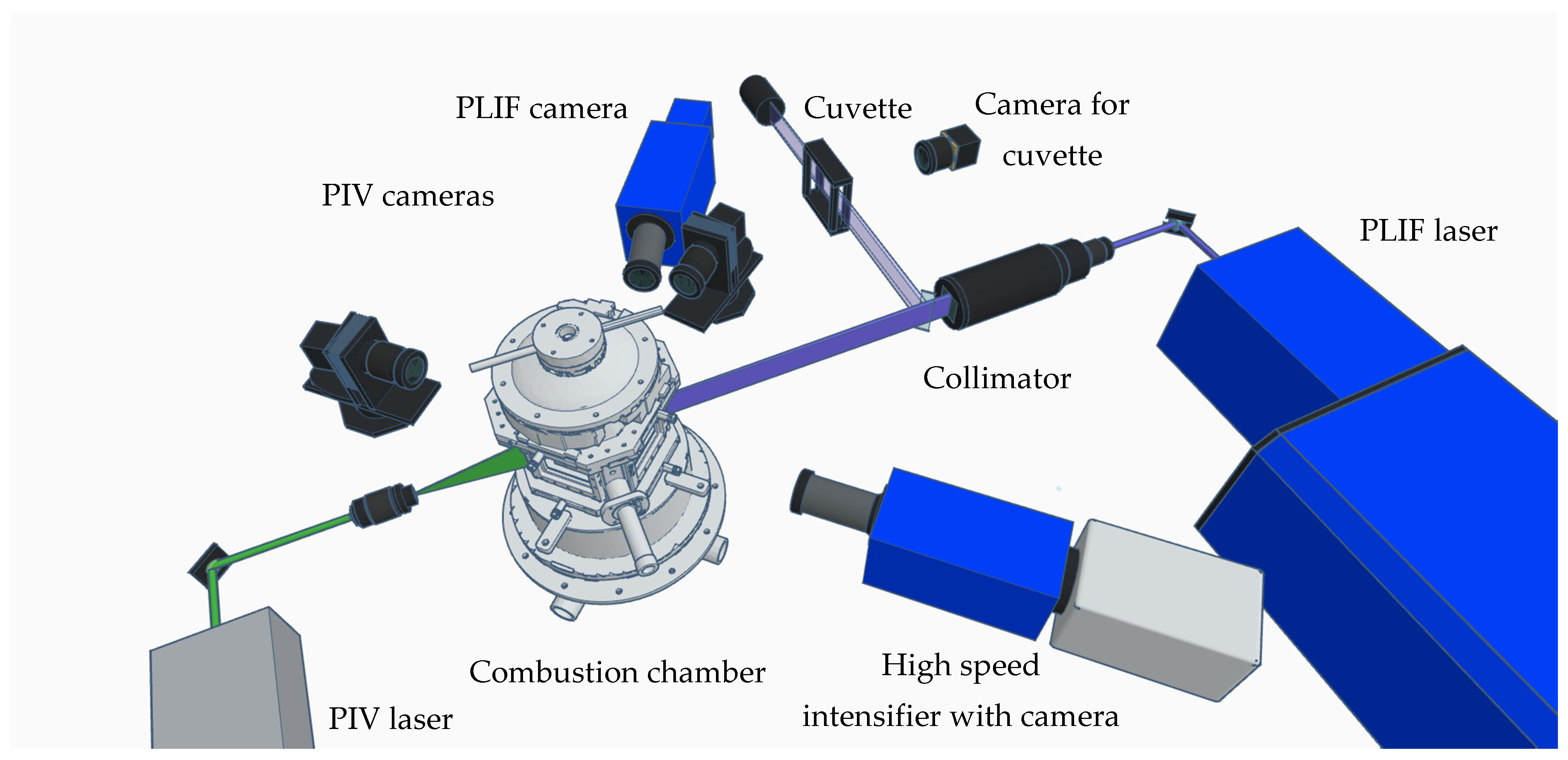
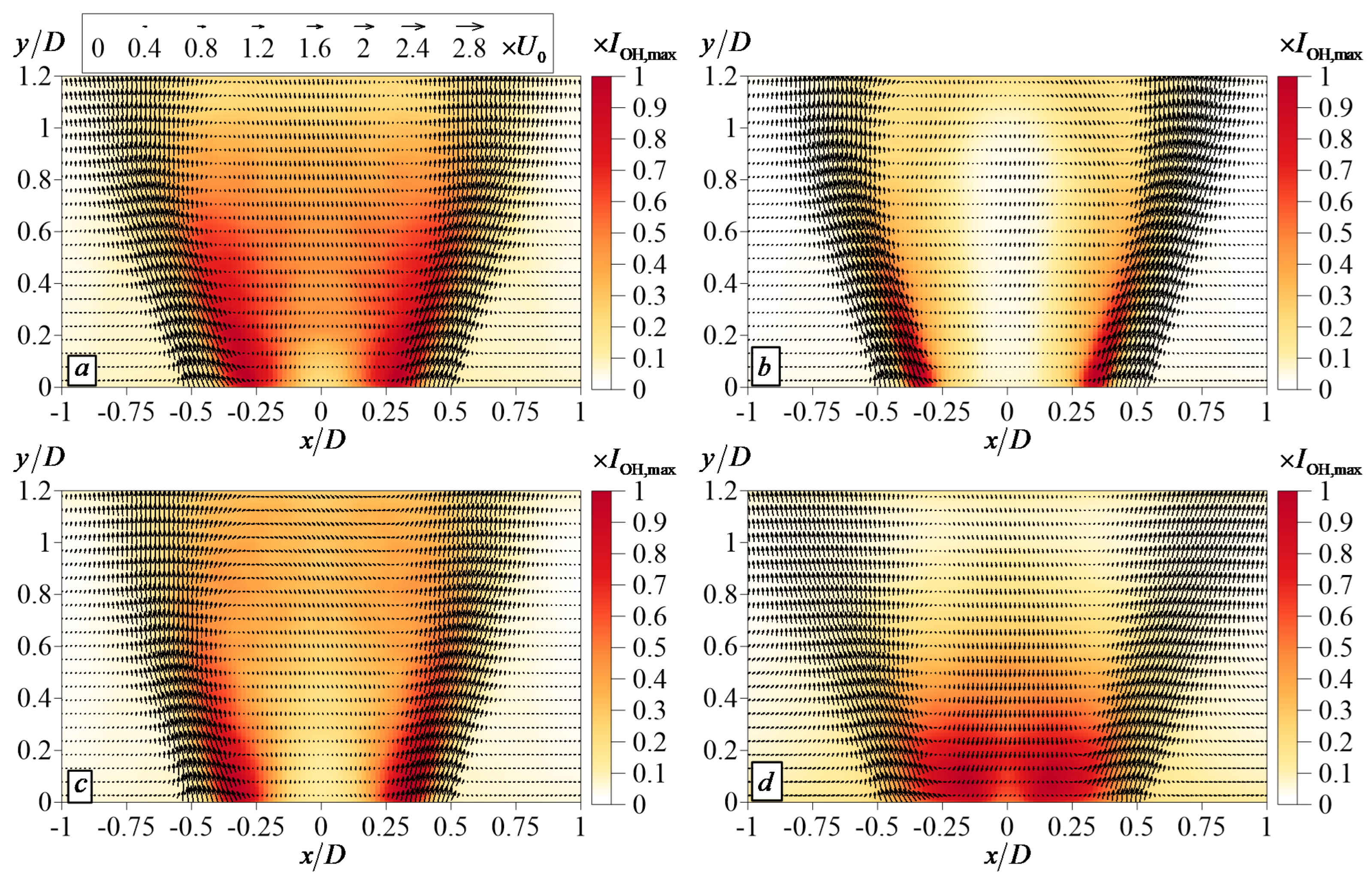
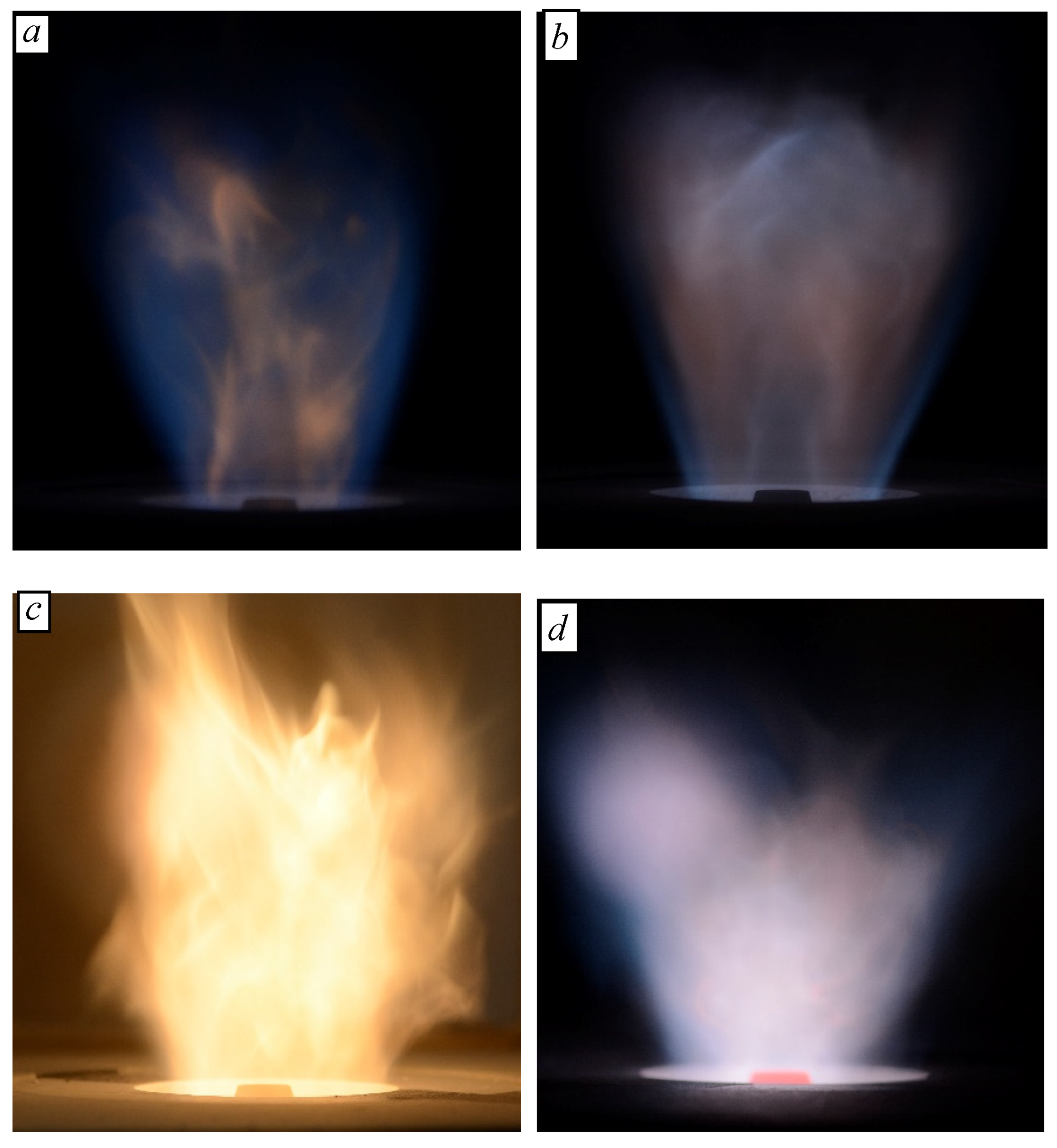
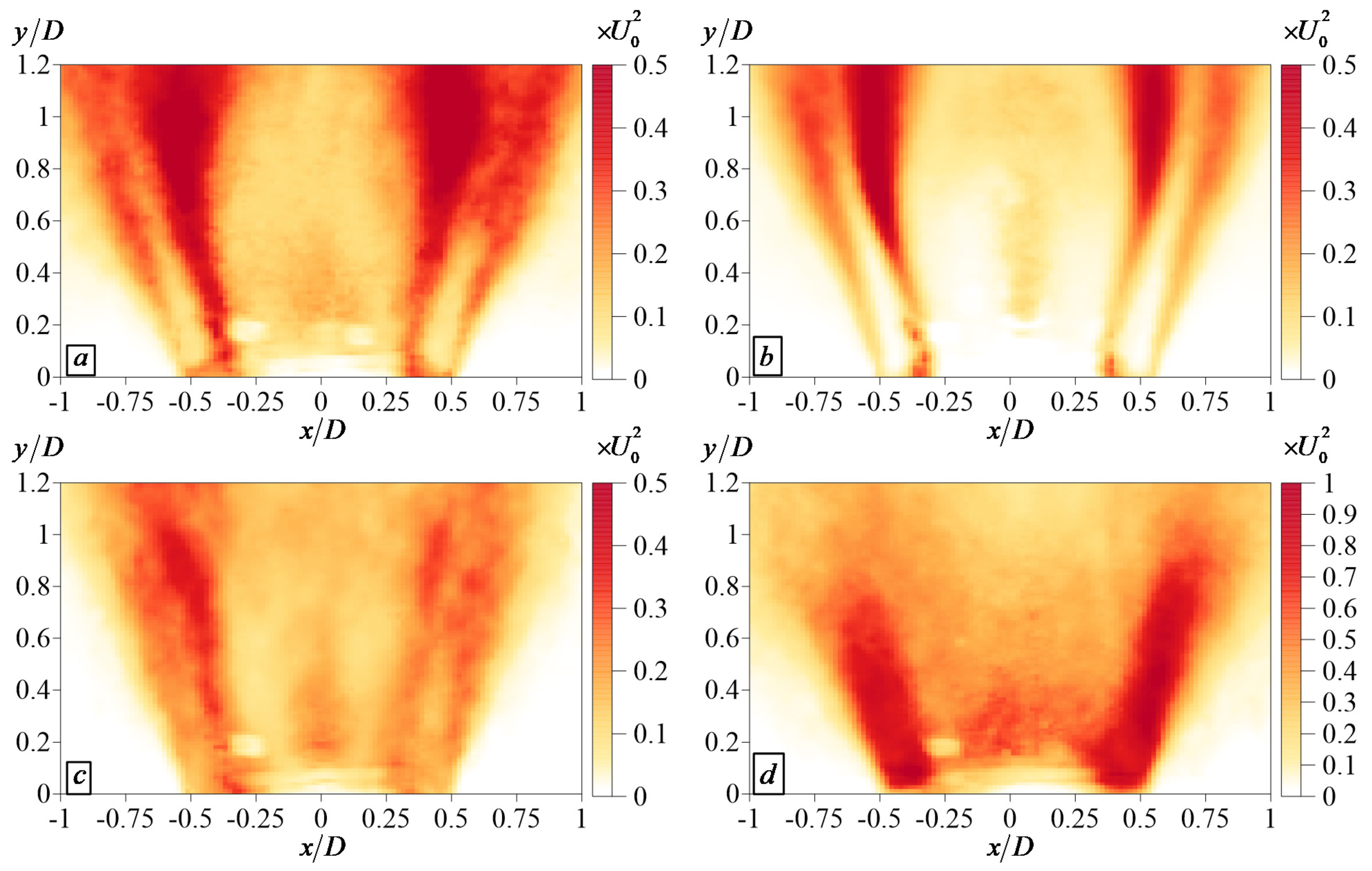
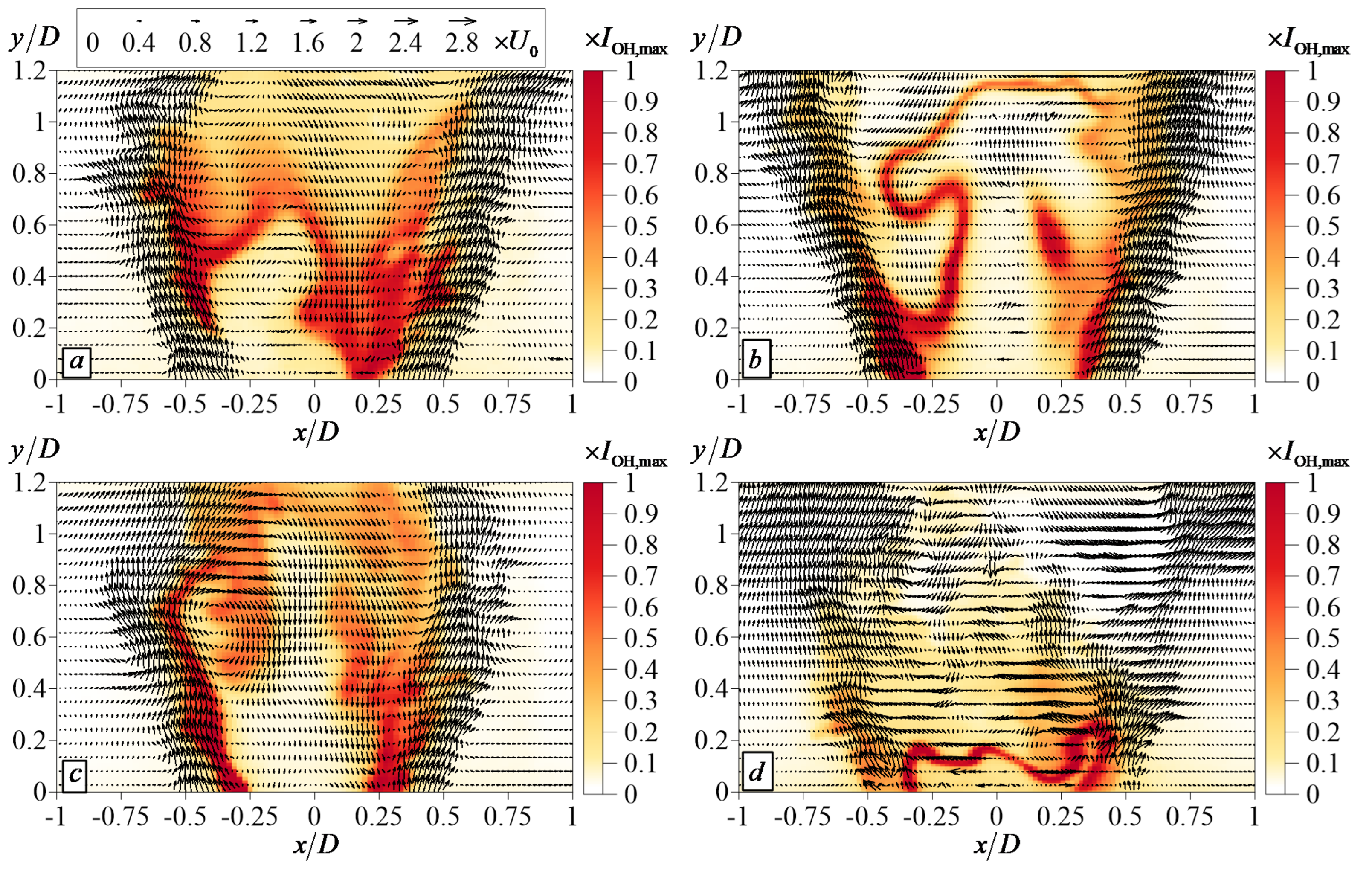
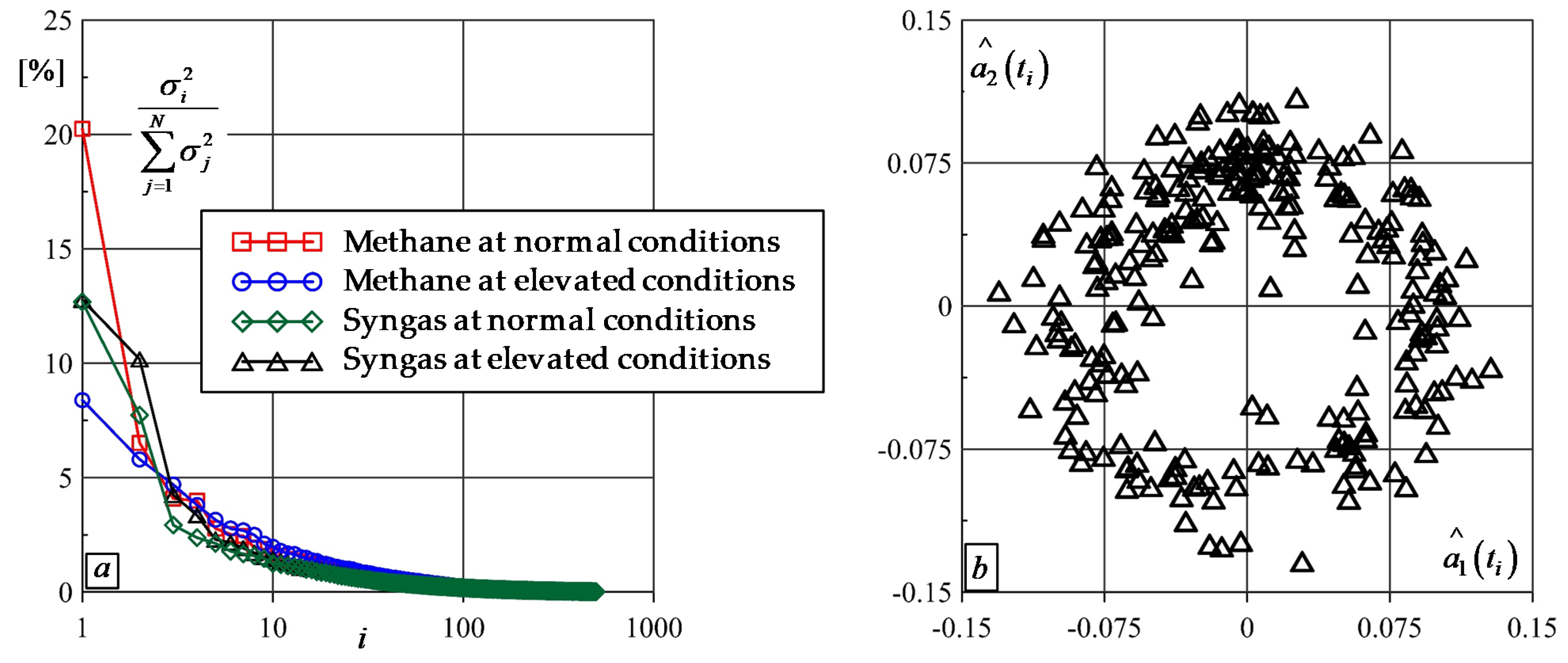
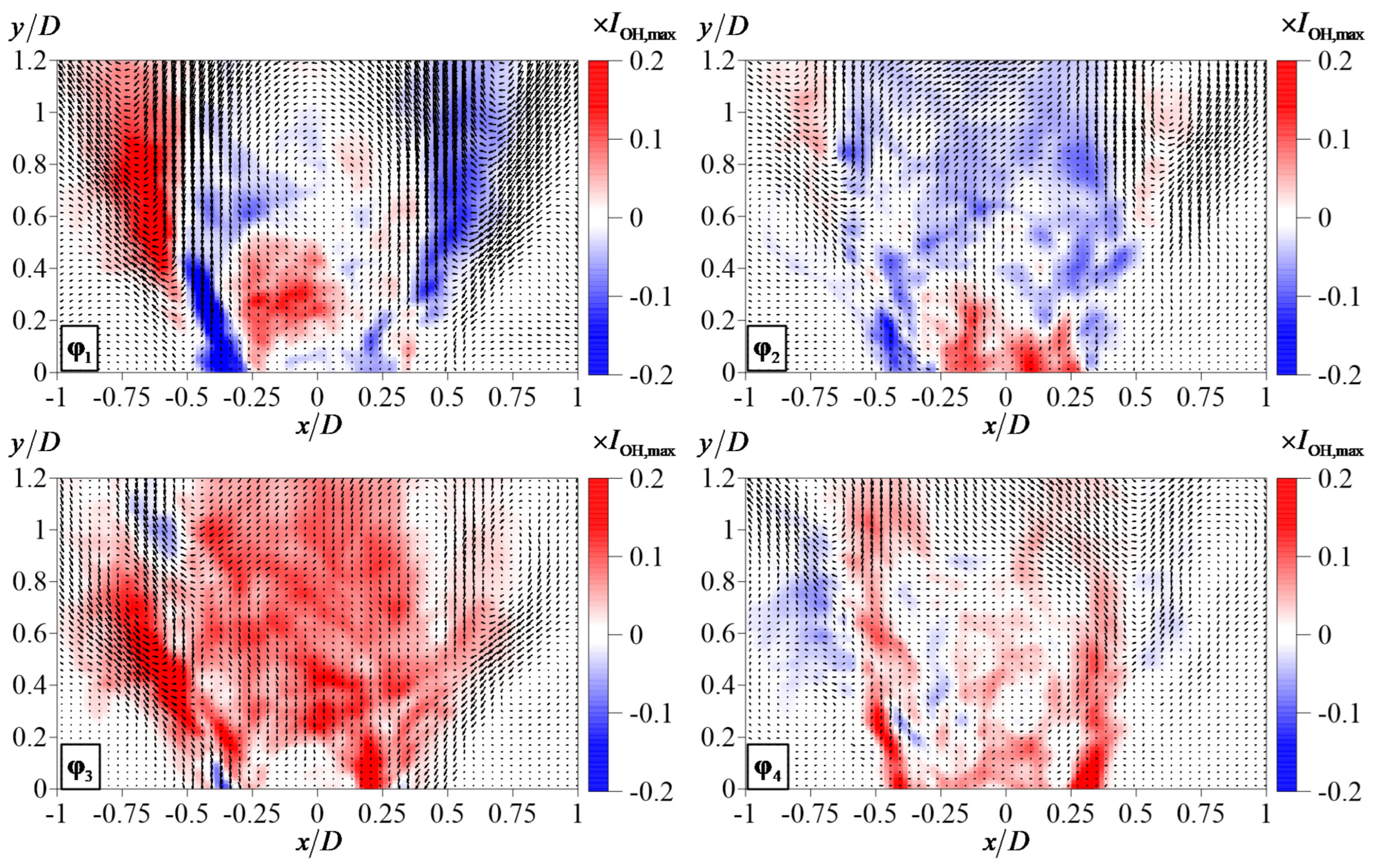
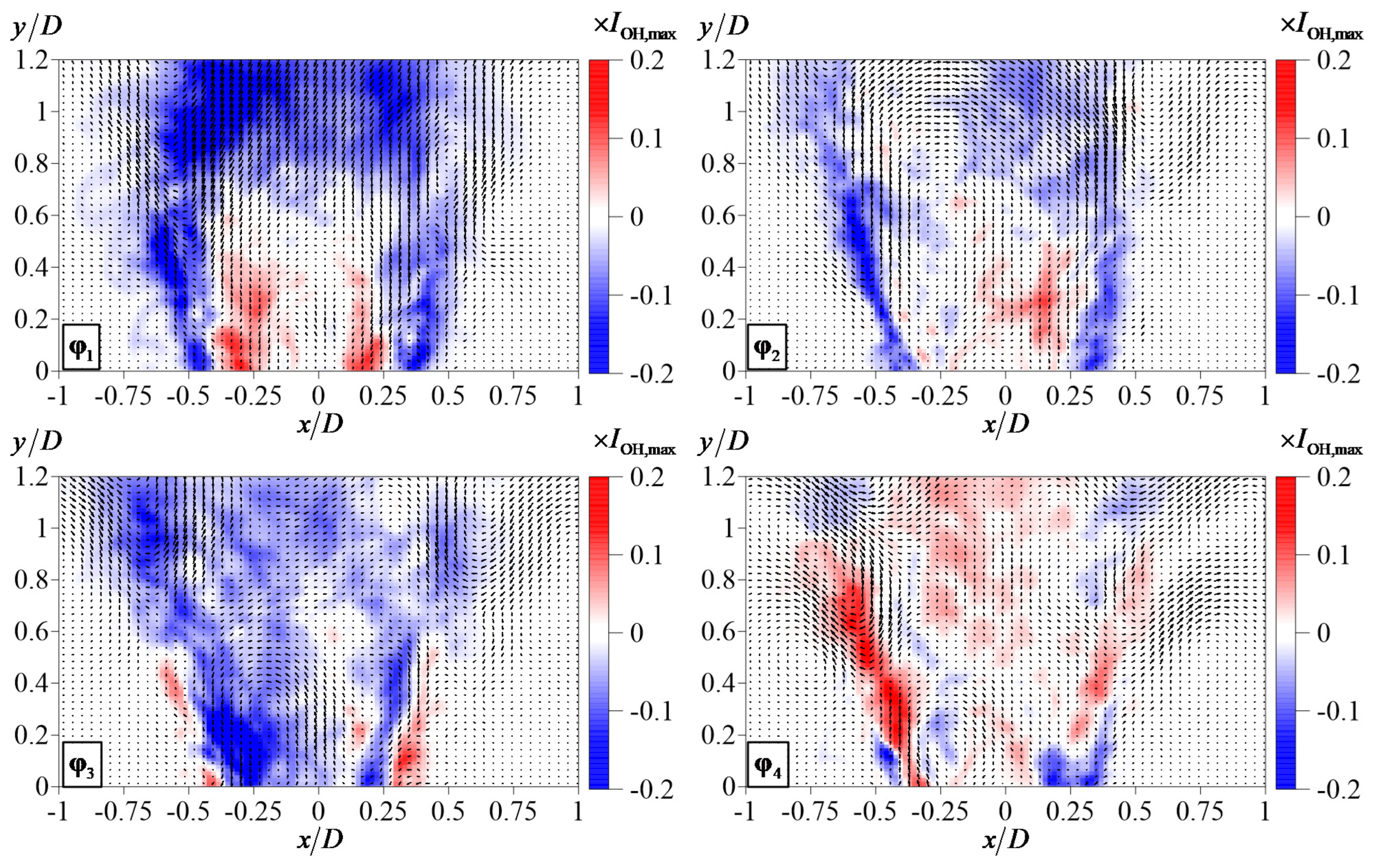
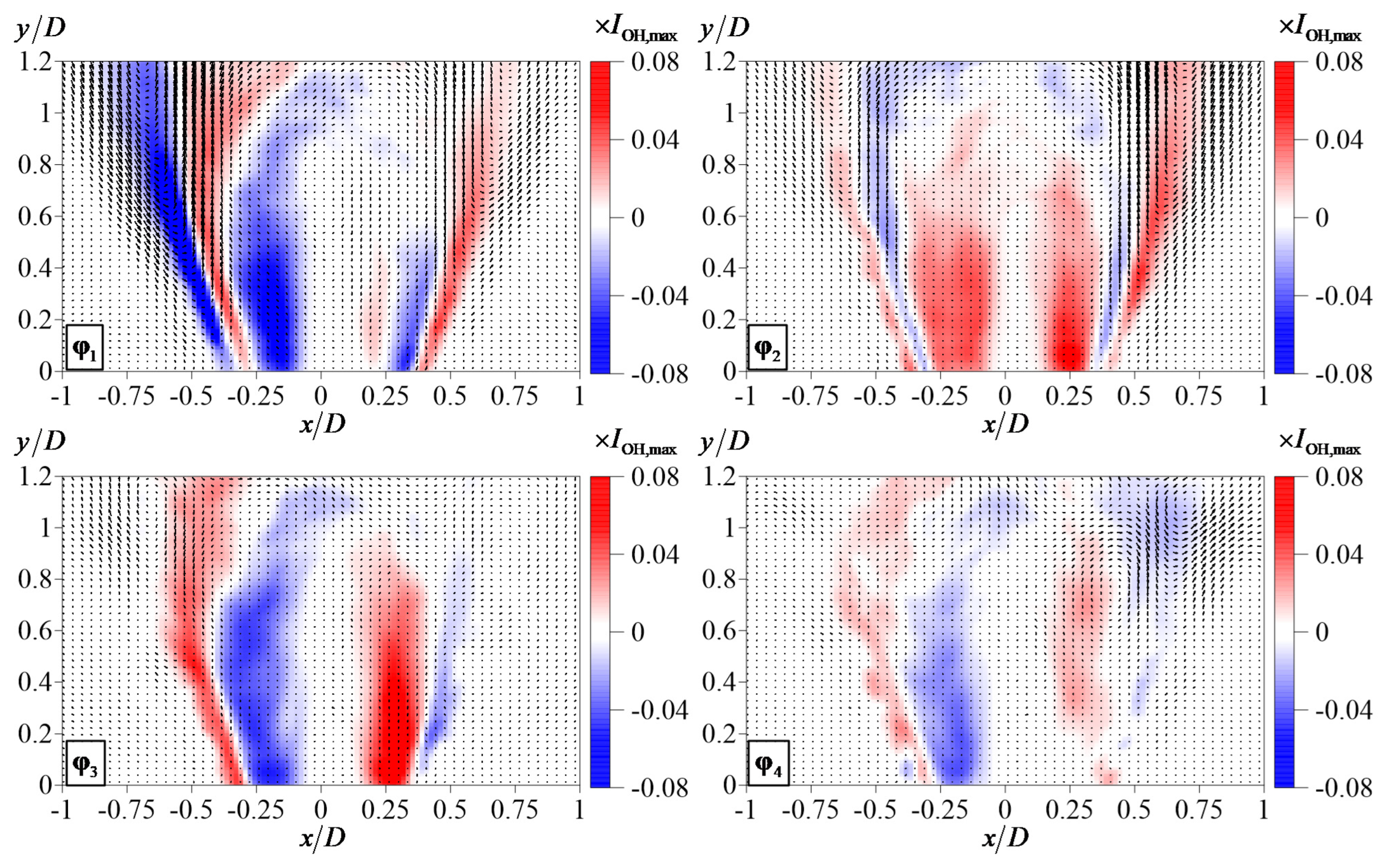
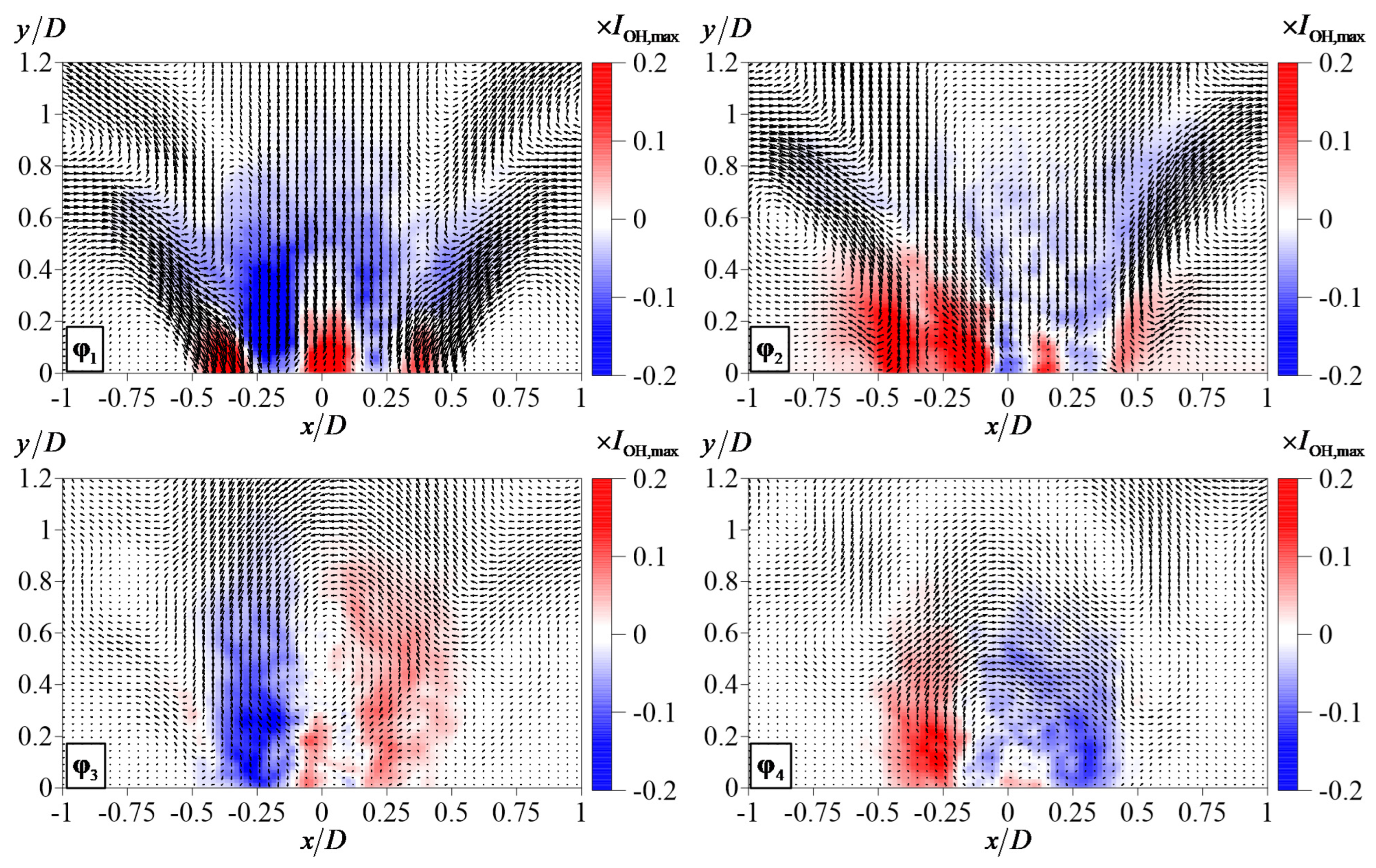
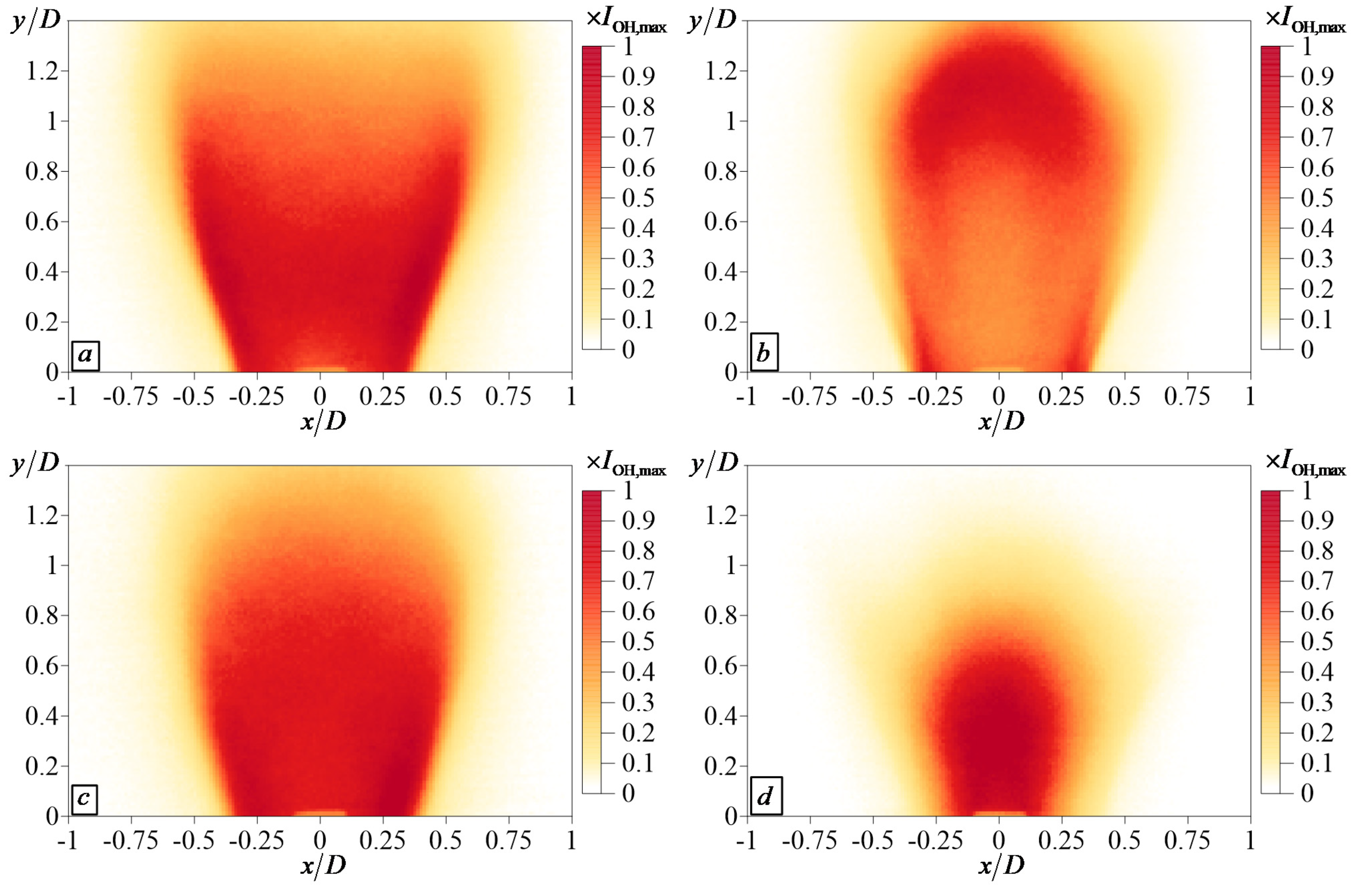
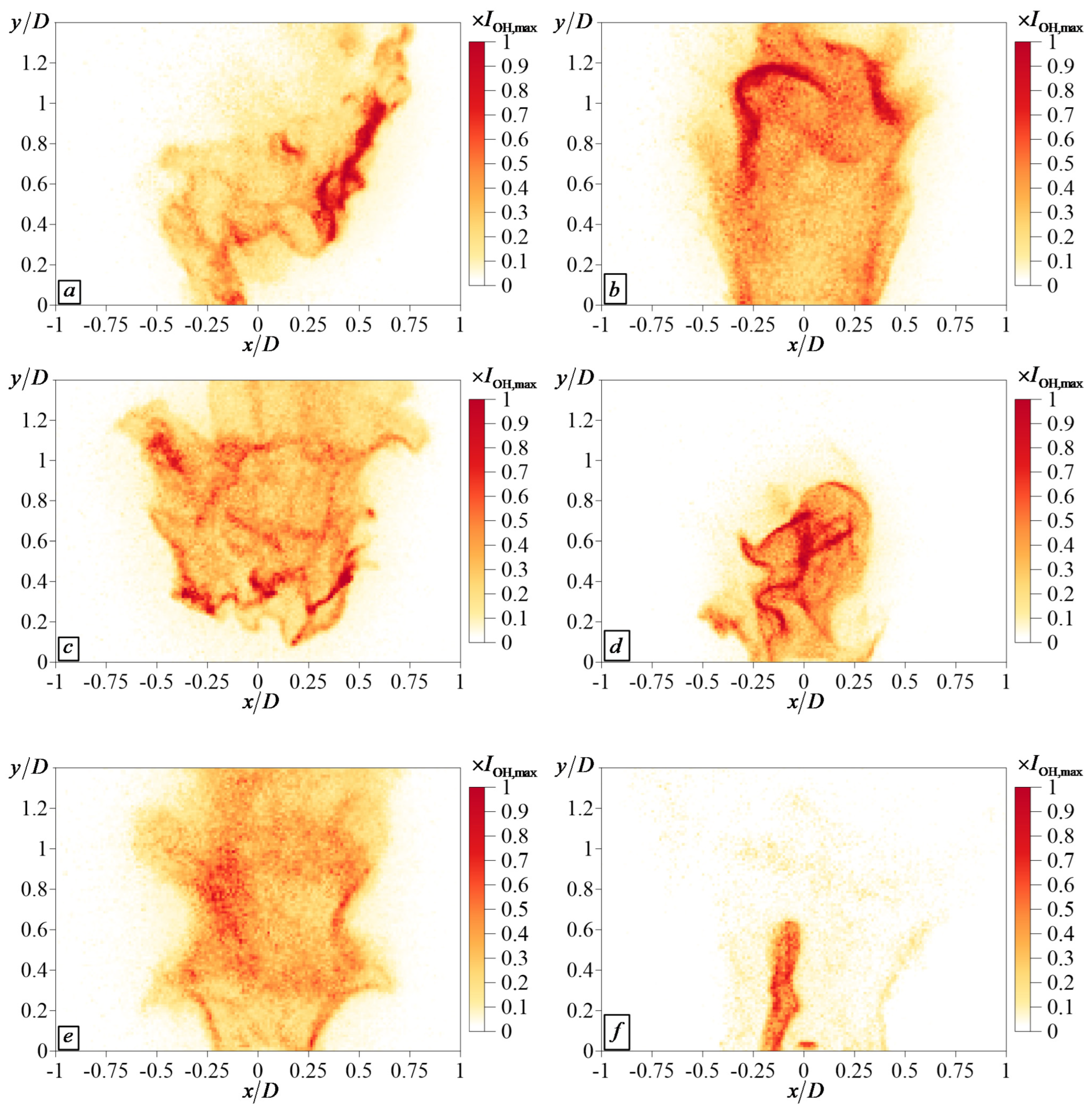
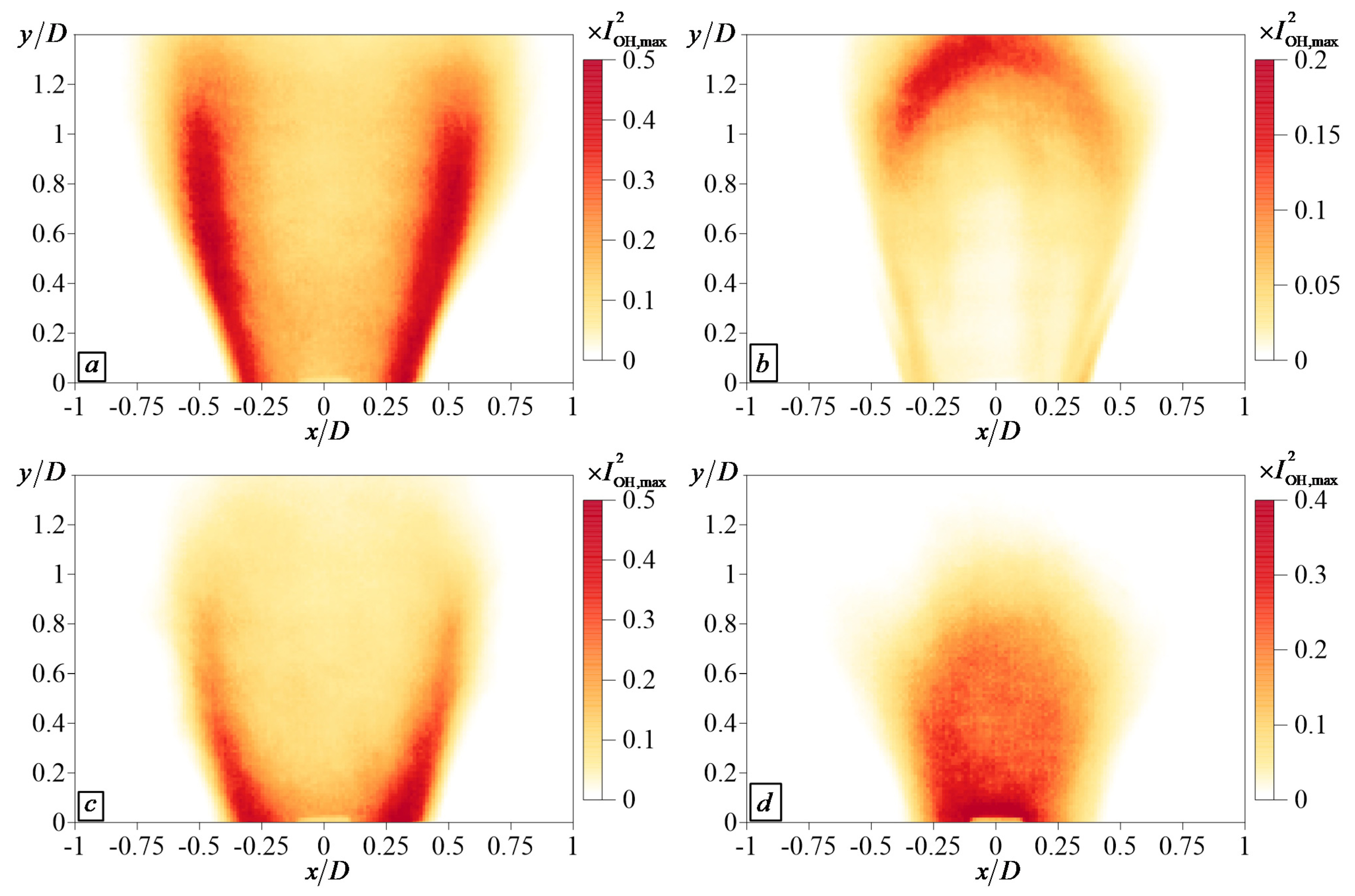
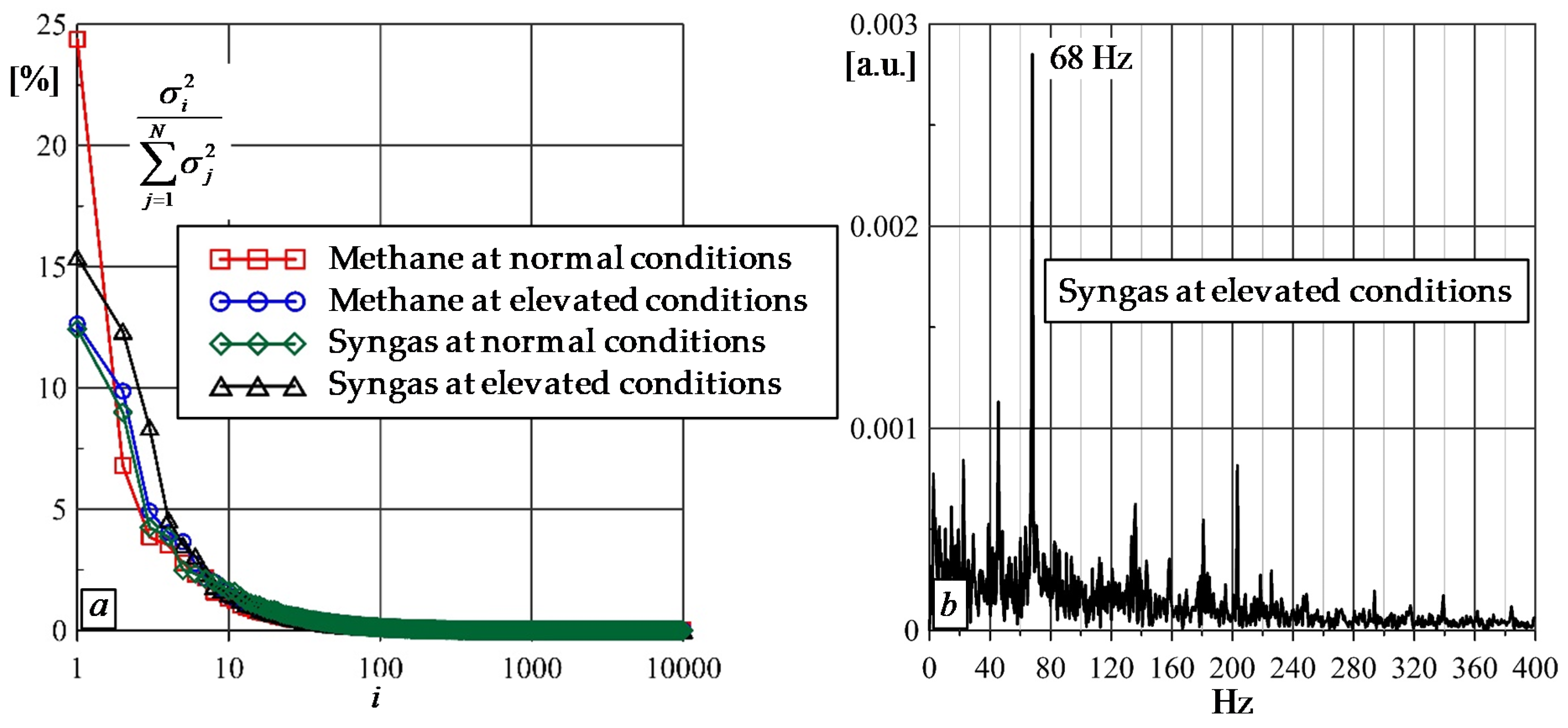
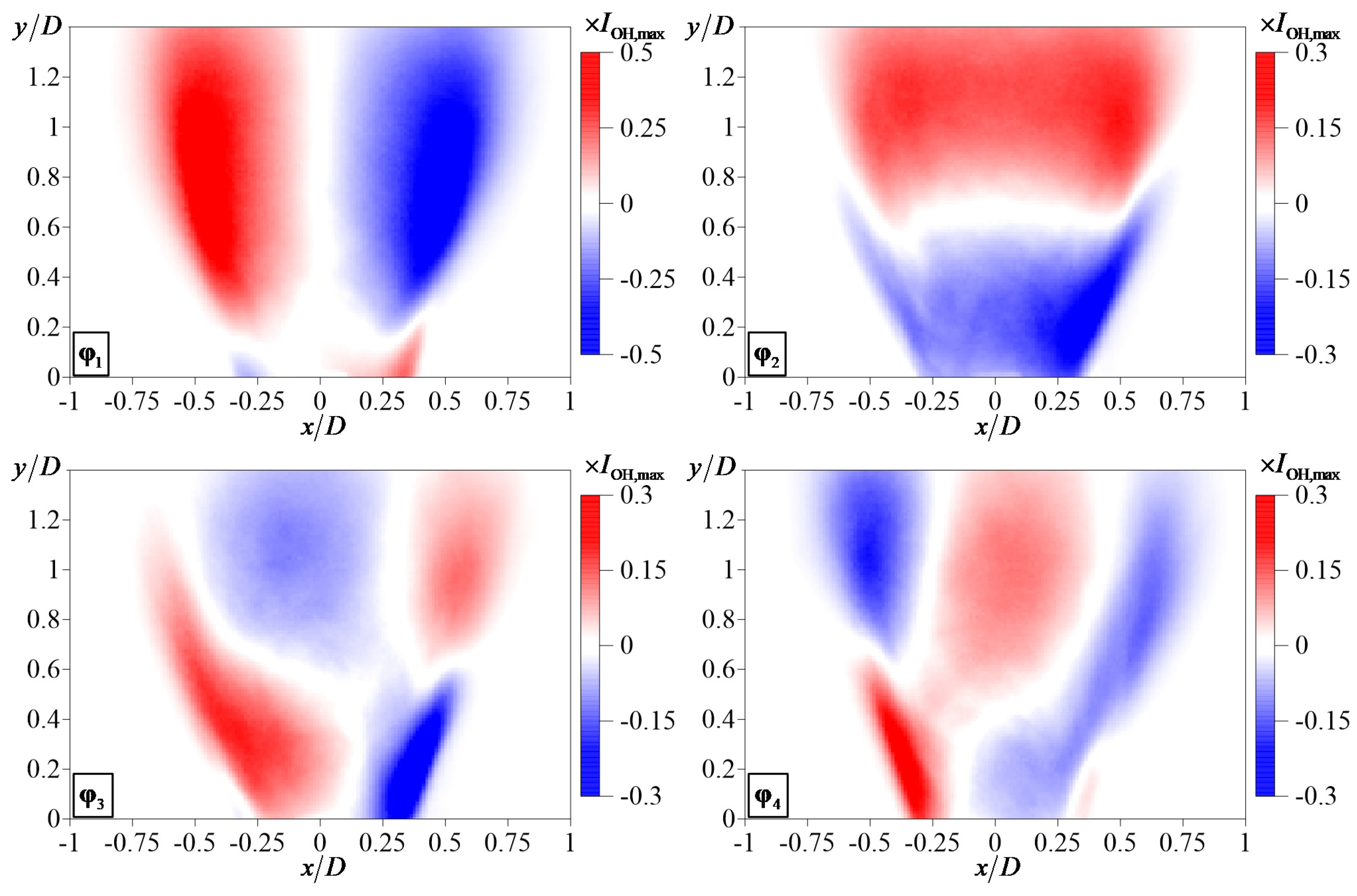
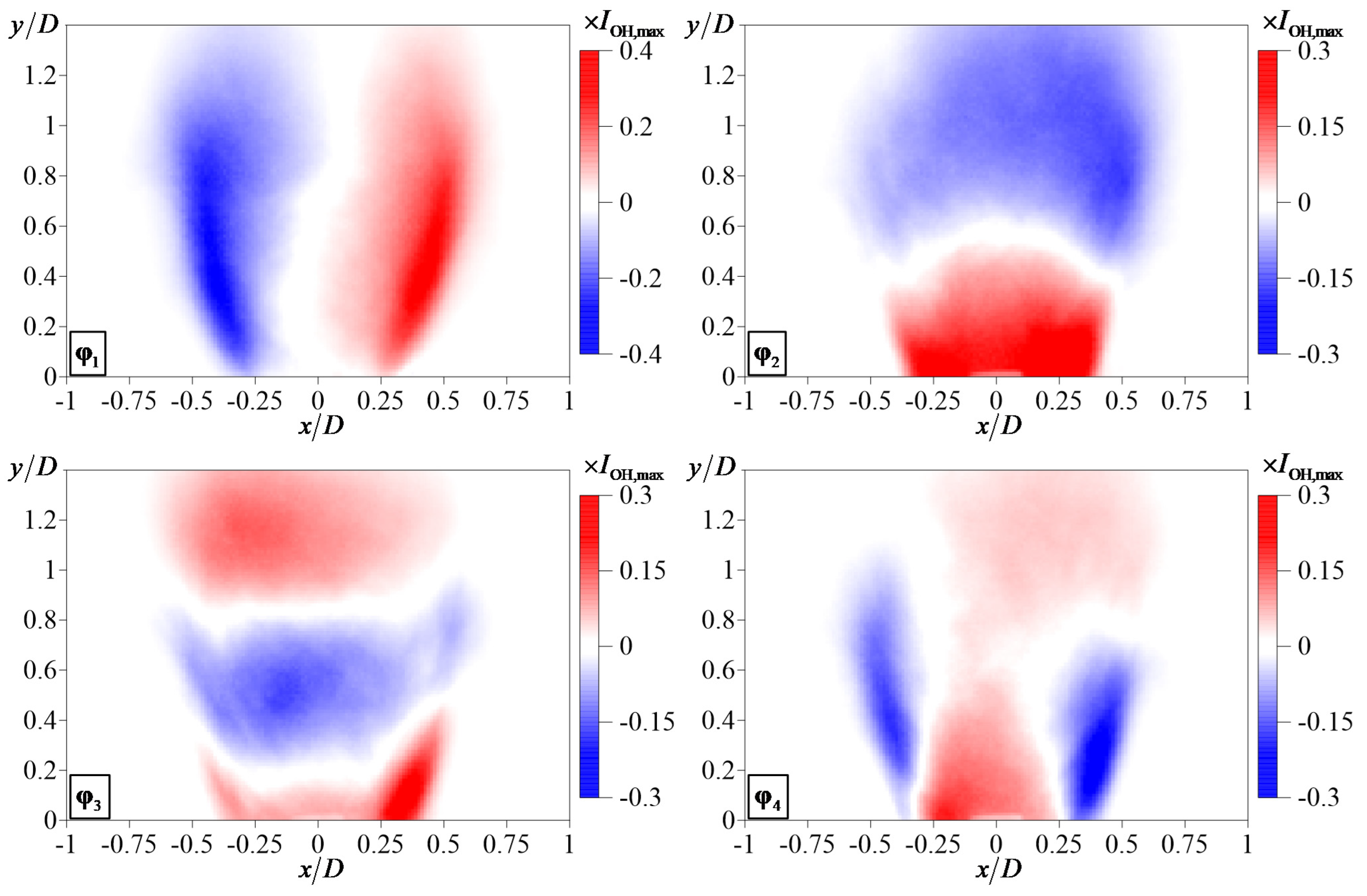
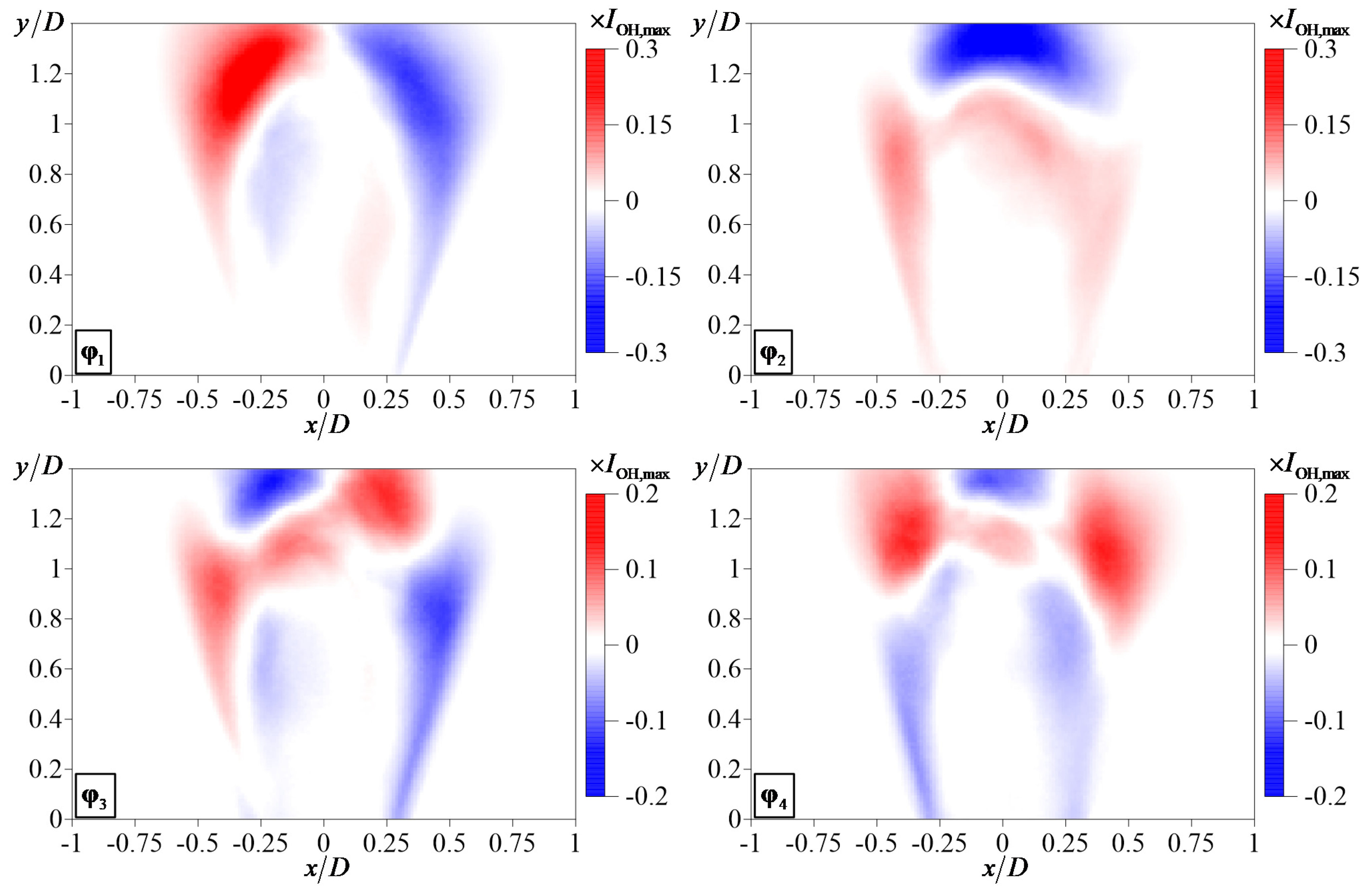
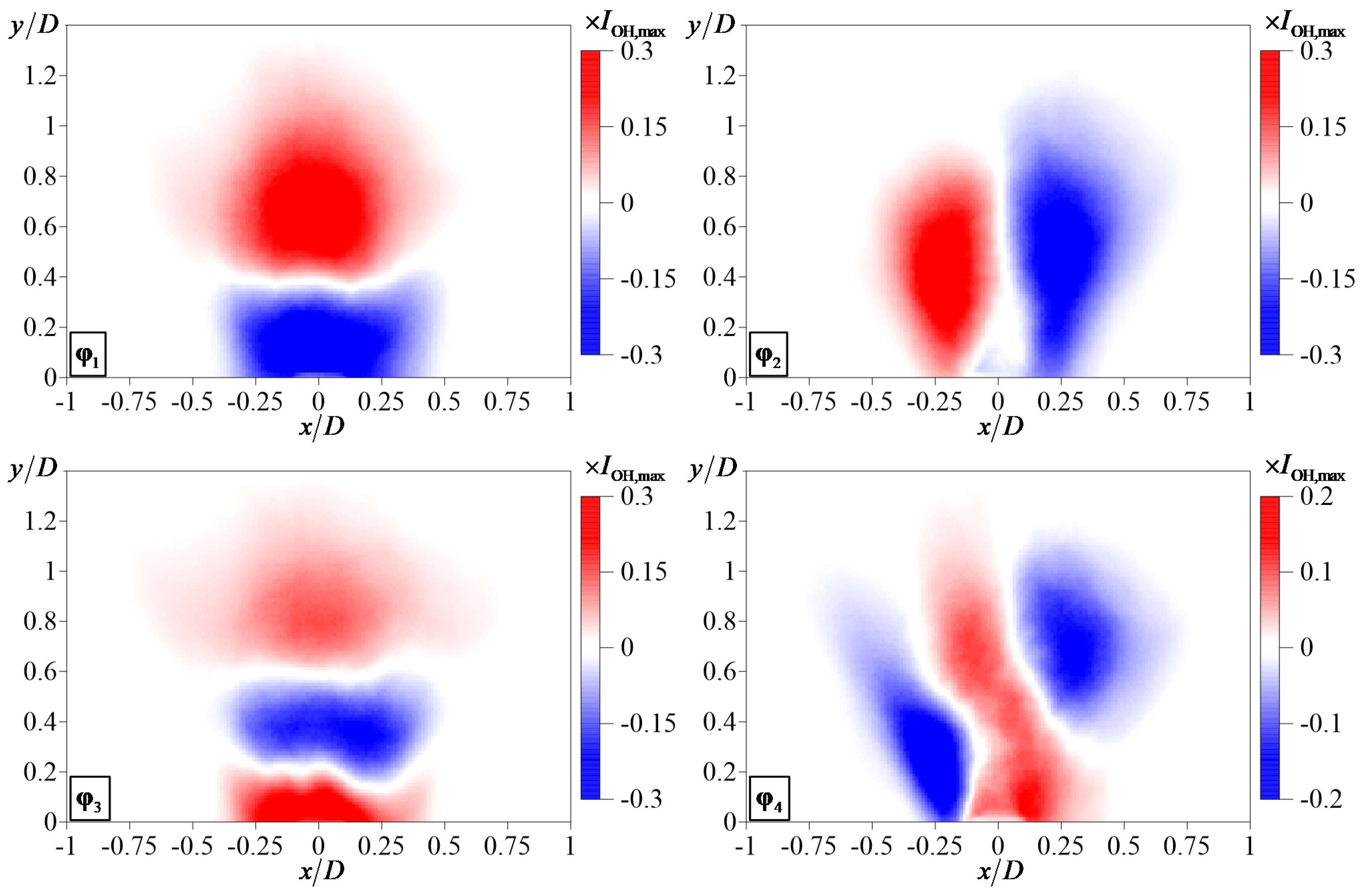
| Air Flowrate (ln/min) | Fuel Type | Fuel Flowrate Main/Central (ln/min) | Equivalence Ratio | Air Temperature (K) | Pressure (atm.) |
|---|---|---|---|---|---|
| 398 | Methane | 10.7/3.2 | 0.33 | 293 | 1 |
| 398 | Methane | 10.7/3.2 | 0.33 | 500 | 2 |
| 398 | Syngas | 29/4.9 | 0.2 | 293 | 1 |
| 398 | Syngas | 29/4.9 | 0.2 | 500 | 2 |
Publisher’s Note: MDPI stays neutral with regard to jurisdictional claims in published maps and institutional affiliations. |
© 2021 by the authors. Licensee MDPI, Basel, Switzerland. This article is an open access article distributed under the terms and conditions of the Creative Commons Attribution (CC BY) license (https://creativecommons.org/licenses/by/4.0/).
Share and Cite
Dulin, V.; Chikishev, L.; Sharaborin, D.; Lobasov, A.; Tolstoguzov, R.; Liu, Z.; Shi, X.; Li, Y.; Markovich, D. On the Flow Structure and Dynamics of Methane and Syngas Lean Flames in a Model Gas-Turbine Combustor. Energies 2021, 14, 8267. https://doi.org/10.3390/en14248267
Dulin V, Chikishev L, Sharaborin D, Lobasov A, Tolstoguzov R, Liu Z, Shi X, Li Y, Markovich D. On the Flow Structure and Dynamics of Methane and Syngas Lean Flames in a Model Gas-Turbine Combustor. Energies. 2021; 14(24):8267. https://doi.org/10.3390/en14248267
Chicago/Turabian StyleDulin, Vladimir, Leonid Chikishev, Dmitriy Sharaborin, Aleksei Lobasov, Roman Tolstoguzov, Zundi Liu, Xiaoxiang Shi, Yuyang Li, and Dmitriy Markovich. 2021. "On the Flow Structure and Dynamics of Methane and Syngas Lean Flames in a Model Gas-Turbine Combustor" Energies 14, no. 24: 8267. https://doi.org/10.3390/en14248267
APA StyleDulin, V., Chikishev, L., Sharaborin, D., Lobasov, A., Tolstoguzov, R., Liu, Z., Shi, X., Li, Y., & Markovich, D. (2021). On the Flow Structure and Dynamics of Methane and Syngas Lean Flames in a Model Gas-Turbine Combustor. Energies, 14(24), 8267. https://doi.org/10.3390/en14248267








